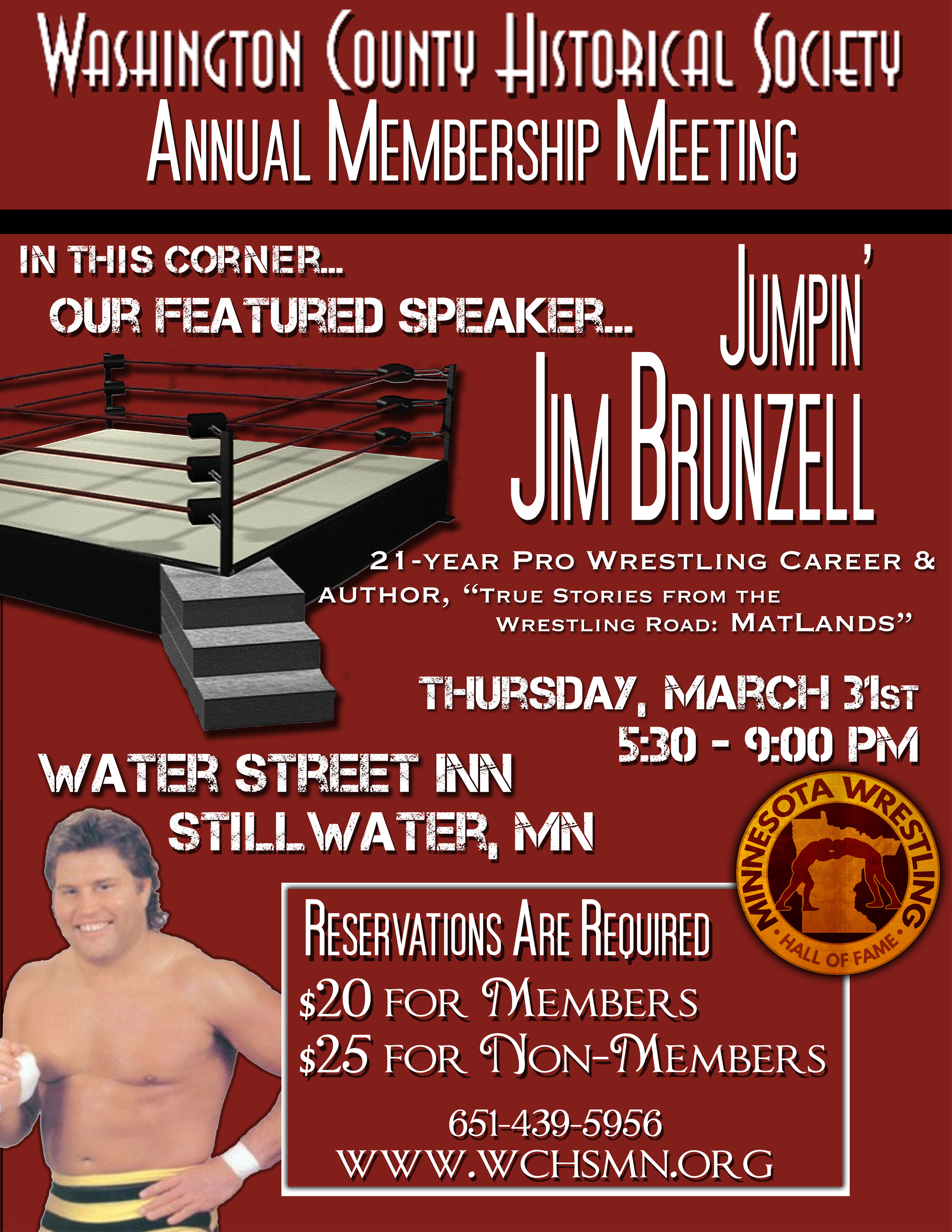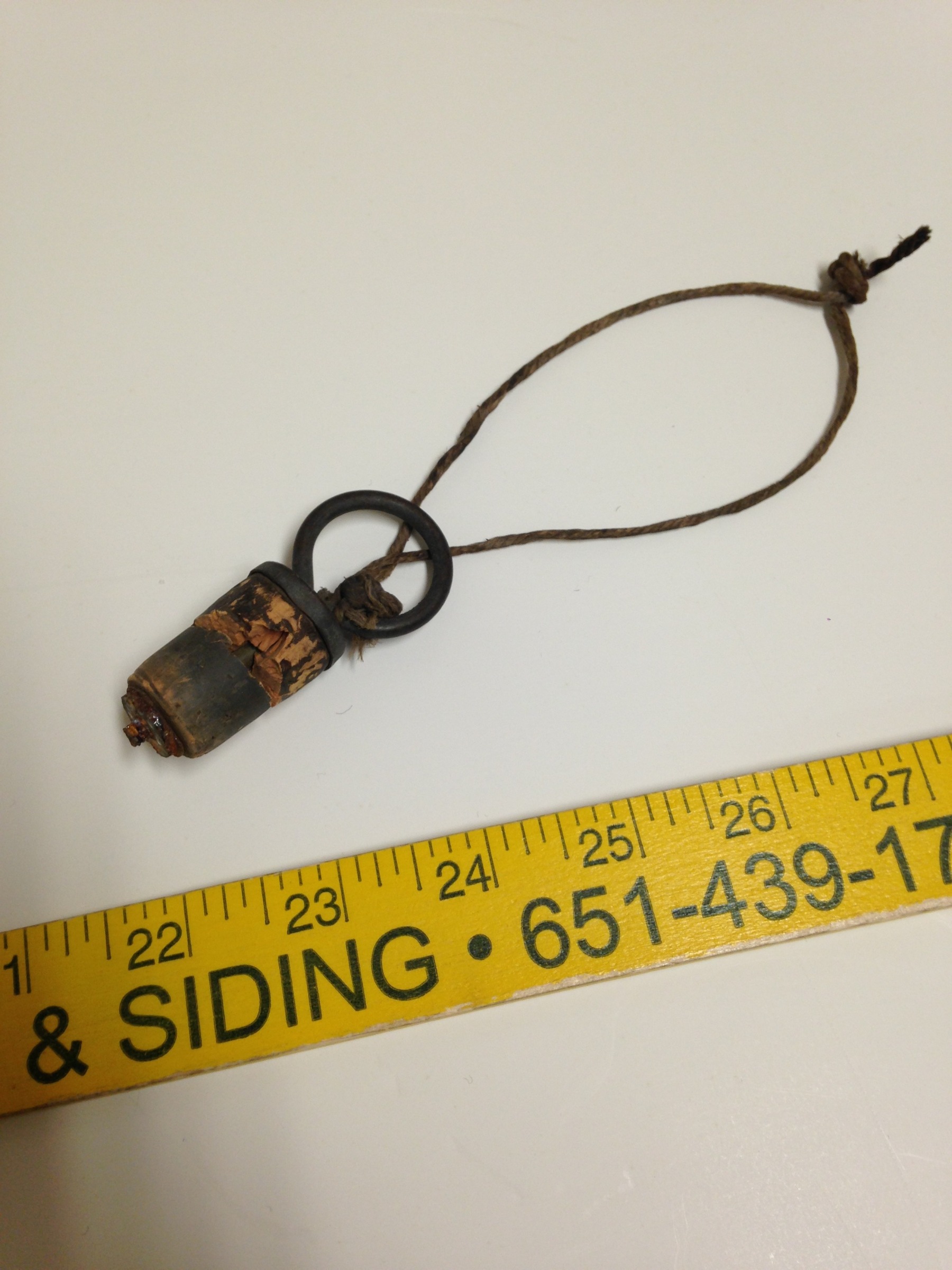Receive the Historical Messenger in your inbox once every two weeks by signing up for our mailing list!
|
This issue: Contents
Tuesday, February 23, 2016
Editor’s Note Hello everybody! Hope you were able to enjoy the nice weather before this morning’s little blanket of snow. Of course, what’s better on a snowy day than the latest Historical Messenger? Well…maybe no snow at all. Okay, but this is a pretty decent runner up. As next month quickly marches towards us (hehe, get it? Whew, I’m hilarious) today’s News section will cover both our Annual Membership Meeting and our call for new WCHS volunteers. Speaking of events, many of our 2016 events are now listed on our Events page on the WCHS website! Be sure to check them out and get them on your calendars now! In today’s “What Is This Thing?!” I’ll let you all know what you taught me about last week’s challenge! Be sure to put any canine friends on a leash before heading into today’s Old News. You may remember taking a survey a few months back where we asked folks like yourself what topics and areas of history you’d be interested in WCHS covering in the future. Now that we’re taking a serious and in-depth look at the results, we’re finding that many of you indicated you’d be interested in learning more about “Native American History”. It’s definitely a topic that deserves more attention that it receives. But Washington County’s Native American history doesn’t begin with the the Dakota and Objibwe. No, you need to turn the clock back much, much further. In today’s Featured Article, I’ll invite you to imagine what the world might have been like in 10,000 B.C.E. You wouldn’t be able to walk along where Stillwater’s Main Street will be without using scuba equipment. The retreating glaciers of the Ice Age have left Minnesota’s rivers flooded and swollen. And the subsequent strange ecology supports herbivores and carnivores who today you’ll only find in Museums of Natural History. Anthropologists estimate that at this time, between 5 to 10 million people exist across the entire planet. On the other side of the world, the Great Pyramids at Giza won’t be built for another seven and a half thousand years. And perhaps the most strange fact about this pre-historic world, is that in 10,000 B.C.E., our homo sapiens ancestors may have still been competing with homo floresiensis for the title of “Sole Surviving Human Species”. It is in this foreign world that Washington County’s first residents lived their lives in what we now call home. Want to learn more about the history of Washington County? “Like” WCHS on Facebook and follow us on Twitter! Sean Pallas Historical Messenger editor and Warden’s House Site Manager WCHS NewsWCHS Annual Membership Meeting with Jumpin’ Jim Brunzell
The Washington County Historical Society Annual Meeting will be held at the Water Street Inn in Stillwater on Thursday, March 31st. The evening will begin with a social hour at 5:30 PM followed by dinner at 6:30 PM. The meeting will begin at 7:30 with an election of board members and conclude with our Featured Speaker – “Jumpin” Jim Brunzell. Over the course of his 21 year long career, Brunzell trained under the legendary Verne Gagne with Ric Flair and the Iron Sheik and even faced former Minnesota Governor Jesse Ventura in the ring. At the meeting, Brunzell will discuss his long history with professional wrestling in Minnesota and his association with the Minnesota Wrestling Hall of Fame. Brunzell will also be selling and signing copies of his new book with “True Stories from the Wrestling Road: MatLands” Reservations are required. WCHS Members – $20.00 Reserve Tickets Online Non-Members – $25.00 Reserve Tickets Online For more information or to make reservations contact Brent Peterson at 651-439-5956 or brent.peterson@wchsmn.org WCHS NewsNew Volunteer Orientation MeetingThe Washington County Historical Society invites those with a passion for history to join us at the Warden’s House Museum on Saturday, March 19th at 1:00 PM for a new volunteer orientation/informational meeting. Whether you’d like to indulge your inner historian or build up your resume, volunteering with WCHS can be a very rewarding experience. Volunteers assist the historical society in a wide variety of ways, including: cataloguing our artifact inventory, creating scrapbooks of historic photographs and newspaper articles, and, of course, guiding visitors through our museums. Our goal is to tailor individual volunteer experiences to suit the needs and interests of the volunteer! At the March 19th meeting, we’ll take a tour of the Warden’s House Museum and provide further information about volunteering with WCHS. The Warden’s House is located at 602 Main Street North in Stillwater, MN. Please contact Sean Pallas at spallas.wchs@gmail.com or 651-439-5956 with any questions regarding volunteer opportunities or this orientation meeting. What is This Thing?!
What Is This Thing?! (Round 29)When selecting last issue’s What Is This Thing?! I thought I’d make things a little more challenging by only featuring a section of complete artifact set. When you come across this particular item in our museum, you’ll see it displayed alongside a stoneware clay beer bottle as an example of early bottling technology from the 1870s. Now, I had a few folks guess that it was a boat plug but the overwhelming majority of you said it was a Civil War canteen stopper. Among this number was a few re-enactors who are extremely familiar with standard Union soldier equipment. And you know what, all of you were absolutely correct. This canteen plug has either been re-purposed to serve as the beer bottle stopper or simply incorrectly displayed alongside it. Even a simple Google search of “Civil War Canteen Stopper” will bring up pages and pages of photos displaying caps with the exact same look and design as ours. So, it looks like when I asked “What Is This Thing?!” last issue, it was a genuine question! I promise I know what this week’s mystery item is though! Can you identify the WCHS artifact photographed above? Can you guess its use? If you’d care to venture an answer, you can send an email to me at spallas.wchs@gmail.com, tweet @WCHSMN, or post your guess on our Facebook page. Good luck! Old NewsStrict Rules For FidoExamining a society’s laws are a good place to begin to understand that society’s concerns. Folks usually don’t bother writing laws banning some activity unless that activity has become a problem. So what the heck was going on with all the dogs in Stillwater in the early 1900s?! In October of 1883, the Stillwater Daily Sun made mention of a “a vicious canine, which bit a little boy some time last week on Chestnut Street,” and followed it up a few short months later with, “John Nolan’s dog attempted to chew up a small boy on the street to-day, and the police have ordered a dose of cold lead for the canine.” After enduring assaults by wild and allegedly domesticated dogs for twenty years, the leaders of Stillwater came up with the following drastic measure for the four-legged citizens of the city. Must Muzzle Dogs – Stillwater Messenger – February 23, 1907 The city council has amended the ordinance relating to dogs and it is now imperative that all dogs running at large must be muzzled or they will be killed. Every police officer is ordered to destroy dogs running at large not provided with muzzles. Featured ArticleTwelve Thousand Years of Washington County Historyby Robert Vogel Following common practice, we sometimes refer to the people who lived in what is now Washington County before the first European explorers arrived on the scene as prehistoric Indians. The term “prehistoric” is a misnomer – because they lacked a written language, virtually all that we know about these ancient cultures comes from the archeological record, but this heritage is nevertheless historic in that it tells the story of how people lived in earlier times, provides insights into how they viewed the changes in the world around them, and connects our recent past with the full continuum of the human experience. For the sake of convenience, archeologists categorize the data from the sites they excavate using a framework of cultural traditions based on chronology, material culture, and basic subsistence, and other characteristics. The four main cultural periods represented by archeological sites in Washington County are: the Paleo-Indian tradition, which lasted from about 10,000 to approximately 5,000 B.C.E; the Archaic, which is dated to between 6,000 and 500 B.C.E.; the Woodland, from about 500 B.C.E to 1400 C.E; and the Oneota, which overlaps slightly with the Woodland, between toughly 900 and 1700 C.E. The ancestors of today’s American Indian tribes first appeared in the Washington County area about twelve thousand years ago, a little before the end of the last ice age. The clearest evidence that Indian people have lived continuously in Washington County sine roughly twelve thousand years ago comes to us in the form of beautifully crafted flaked stone spear points which distinguish the Paleo-Indian tradition. These distinctive artifacts are occasionally found along the bluffs and gravels beds bordering the Mississippi River in the Twin Cities area. Paleo-Indian hunters lived in small, highly mobile groups and concentrated on big game animals such as bison, bear, moose, deer as well as several species of now extinct herbivores such as mastodons, mammoths, ground sloths, musk oxen, and giant bison. Of course, in Paleo-Indian times the environment of Washington County was quite different from today. Though there were no longer great sheets of ice on the ground after 14,000 B.C.E, glacial meltwaters filled the valleys of the St. Croix and Mississippi from bluff to bluff and the cold, wet climate favored an ecosystem dominated by open spruce parklands. It took several thousand years for the now familiar oaks and pines to migrate into this region and our “normal” weather pattern is less than 5,000 years old. Under these dynamic environmental conditions the country between the St. Croix and Mississippi Rivers had much to offer the Archaic hunter-gatherers who followed the Paleo-Indian big game hunters. Notwithstanding the mass extinction of large animals at the end of the ice age (in which the Paleo-Indian may have played an important role), there was still abundant animal life, ranging from buffalo on the expanding upland prairies to mussels in the rivers, and the deciduous forest and grassland ecosystem contained literally hundreds of varieties of useful and edible plants. Gathering appears to have been relatively more important than hunting to Archaic folk in our area – just why is not clear, but it may reflect their more settled lifeway which depended upon having a dependable local food source. To the Archaic cultures also goes also the credit for domesticating the first wild plants, which may have begun sometime around five thousand years ago. As time went on, Archaic populations slowly increased and while they were still living in small groups and following a more or less nomadic pattern of subsidence, by around 100 B.C.E. there appears to have been a fairly dense concentration of people living along the Mississippi between the mouths of the Minnesota and St. Croix. Not surprisingly, Archaic-aged spear and dart points are commonly found in local farmers’ “arrowhead” collections throughout the county. The preferred locations for Woodland period habitations sites also seem to have been near streams and lakes, where the bottomland forest provided excellent hunting and gathering, through the broad, bench-like terraces bordering the Mississippi and St. Croix were nearly as good for human habitat as the floodplain areas. The high prairies and dense forests away from the rivers do not seem to have offered much that was useful to Woodland people, whose hunting and gathering economics otherwise closely resembled that of their Archaic forbearers. The prairies in the southern part of the county, for example, probably did not support larger herds of deer, and buffalo bones are conspicuously absent among the materials excavated from Woodland sites there. In contrast to the lifestyle of the Archaic peoples, Woodland period sites reflect two important innovations: pottery-making and mound building. Archeological sites yielding the distinctive Woodland grit-tempered pottery have been found in nearly every community within the county, with the densest concentrations along the Mississippi and St. Croix. Evidence of a fairly large seasonal hunting and fishing camp is preserved at the Schilling Site on the Mississippi River in Cottage Grove, which is part of an important complex of Woodland sites known as the Grey Cloud Island Locality. This site, which was first excavated by the St. Paul Science Museum in 1958, is believed to have been occupied intermittently between about 100 B.C.E. and 1400 C.E. and is one of a small handful of archeological sites in Minnesota that are listed in the National Register of Historic Places. Woodland earthworks, commonly known as “Indian burial mounds,” were once abundant throughout southern Minnesota and antiquarians mapped several hundred in Washington County during the late nineteenth century. Unfortunately, with the exception of several important clusters of mounds preserved in tact in Cottage Grove and Denmark Township, over the last 150 years the majority of these ancient monuments have been destroyed by vandalism, agriculture, or suburban development. The typical Woodland mound was cone or dome shaped, three to eight feet, and fifty to one hundred feet across, constructed in stages over several years. Most though by no means all, contained human remains and association artifacts (“grave goods”) – and for this reason the mounds that survive are regarded as sacred sites by contemporary American Indians and warrant protection as unplatted cemeteries under state law. Washington County also has some unusual mounds, such as the so-called “bedrock mounds” at the Bissell site, where the earth mounds incorporate chunks of native limestone. Sometime during the late Woodland period, a serpentine mound was constructed in what is now downtown Afton, and this is believed to mark the northern limits of a unique regional Woodland variant known as the Effigy Mound Tradition, characterized by earthworks built in the shapes of animals. The combination of productive floodplains and ready access to water transportation routes caused the Indian peoples affiliated with the Oneta tradition to establish themselves along the Mississippi and the lower St. Croix. A regional offshoot of the influential Mississippian cultural tradition with strong ties to the great Indian metropolis at Cahokia (near modern day St. Louis, Missouri), the Oneota culture evolved the first truly tribal communities, built compact villages surrounded with log palisades, carried on extensive trade over vast distances, and introduced a new ceramic technology based on using crushed clamshell as temper. Agriculture was also brought to Minnesota at this time and the river floodplains would have been the best places for planting gardens of corn, beans, squad and tobacco. Though Washington County appears to have been on the northern periphery of the Mississippian sphere of influence, there is one excavated, well documented Oneta site in the county; the Sheffield Site, a summer hunting and fishing camp near Marine that has been radiocarbon dates to about 1300 C.E. When Columbus “discovered” the Americas at the end of the fifteenth century, Washington County appears to have been depopulated. The sites on the Lower Grey Cloud Island and at Point Douglass, for example, appear not to have been occupied after about 1400 C.E., and the written records compiled by the earliest French explorers fail to mention any villages on the Mississippi three centuries later. The reason for this lack of native settlements are not at all clear, but the consensus among present-day archeologists is that the Oneota probably displaced many of the Woodlands groups, who were then pushed into marginal areas. Washington County history is founded on several millennia of ancient American Indian history which we can explore through archeological sites. Just as it is inaccurate to say that the county’s heritage encompasses only the events that occurred since 1837, it is erroneous to picture Native Americans as primitive, uncivilized peoples whose heritage is somehow removed from our own. These cultures were the first explorers in the St. Croix Valley, named all the landmarks along the Mississippi, altered the natural distribution of plants and animals wherever they settled, and were the area’s first farmers, lumbermen, boatmen, politicians, warriors, and artists. |
Events
More information: WCHS Events >>> Preserve the Past, Share in the Future!Become a member of the Washington County Historical Society! Membership is one way that you can help support the Washington County Historical Society. Your membership helps us collect, preserve, and disseminate the history of Washington County for county residents and visitors in the belief that a historical perspective enhances our understanding of community and sense of place. Benefits of membership:
The Washington County Historical Society has depended on membership ever since it was formed in 1934. Please show your support for the organization by becoming a member today. More: WCHS Membership >>> Mission StatementWashington County Historical Society collects, preserves, and disseminates the history of the county and state of Minnesota.
|
|||||||




